
Alfred Bryan was a Canadian lyricist.
Ballard MacDonald was an American lyricist, who was one of the writers of Tin Pan Alley.
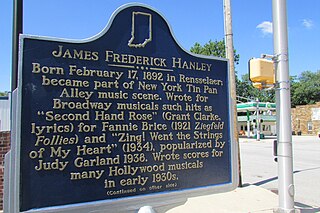
James Frederick Hanley was an American songwriter and author.
Albert Wilfred Barbelle (1887–1957) was an American artist known well for his work in advertising, particularly cover art for sheet music of Tin Pan Alley. He also illustrated the first Mickey Mouse book.
"Someday They're Coming Home Again" is a 1917 song written during World War I. Lyrics and music was written by Harry Hilbert. The song was published by M. Witmark & Sons in New York City. The cover of the sheet music depicts a mounted officer leading a silhouette of marching soldiers. He is carrying a company flag.
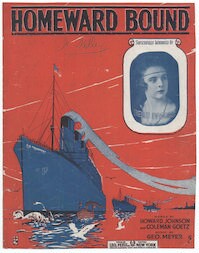
Homeward Bound is a World War I era song that says the war will soon be over, and the soldiers will be able to return home. It has a hopeful message and was meant to comfort both soldiers and the family and friends of soldiers. It was composed by George W. Meyer, written by Howard Johnson and Coleman Goetz, and produced by Leo. Feist, Inc. in 1917.

"When the Boys Come Home" is a World War I song. It was first published as sheet music in 1915 with music by Oley Speaks and lyrics by John Hay.
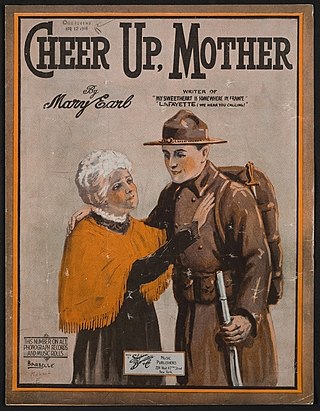
"Cheer Up, Mother" is a World War I era song released in 1918. Mary Earl composed the music and wrote the lyrics. Shapiro, Bernstein & Co. of New York, New York published the song. Artist Albert Wilfred Barbelle designed the sheet music cover. It features a mother saying good-bye to her soldier son. It was written for both voice and piano.

"When the Lilies Bloom in France Again" is a World War I era song released in 1918. Robert Levenson wrote the lyrics. George L. Cobb composed the music. It was published by Walter Jacobs of New York City and Boston, Massachusetts. There are two versions of the sheet music cover. One was designed by Rose Starmer. The cover is described as an "artistic words only cover." Another cover is a painting of a garden, with lilies in the foreground. The song was written for both voice and piano.
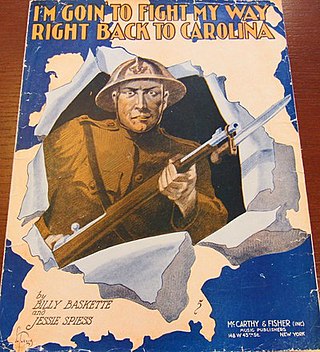
"I'm Goin' To Fight My Way Right Back to Carolina" is a World War I era song written and composed by Billy Baskette and Jessie Spiess. The song was published in 1918 by McCarthy & Fisher, Inc. of New York City. The sheet music cover was designed by Andre C. De Takacs. It features an armed soldier tearing through the cover. The song was written for both voice and piano.

"When the Sun Goes Down in Normandie " is a World War I era song released in 1918. Jeff Branen wrote the lyrics. Evans Lloyd composed the music. The song was published by Jeff Branen Publisher of New York, New York. The sheet music cover features a group of soldiers sitting around the camp fire. In the foreground is an armed soldier on guard duty walking through the campground. The song was written for both voice and piano.

"So Long, Mother" is a World War I era song released in 1917. Raymond B. Egan and Gus Kahn wrote the lyrics. Egbert Van Alstyne composed the music. The song was published by Jerome H. Remick & Co. of Detroit, Michigan. On the cover is a soldier and mother in an embrace. To the left is an inset photo of singer Al Jolson. It was written for both voice and piano.

"We Don't Want the Bacon (What We Want Is a Piece of the Rhine)" is a World War I–era song released in 1918. The lyrics were written by "Kid" Howard Carr and Harry Russell, and the music composed by Jimmie Havens. The song was published by Shapiro, Bernstein & Co. of New York City. On the cover is a soldier tearing through a large piece of bacon with his bayonet. A fearful-looking Kaiser Wilhelm II is standing on the bacon. It was written for voice and piano.

"When the 'Yanks' Come Marching Home" is a World War I era song released in 1917. William Jerome wrote the lyrics. Seymour Furth composed the music. It was published by A.J. Stansy Music Co. of New York City.
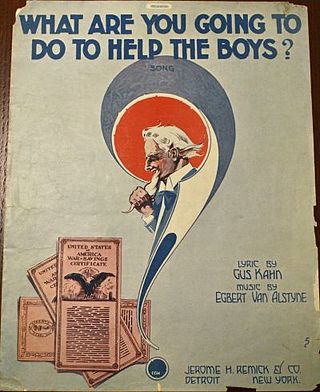
"What Are You Going to Do to Help the Boys?" is a World War I era song released in 1918. Gus Kahn wrote the lyrics. Egbert Van Alstyne composed the music. It was published by Jerome H. Remick & Co. of Detroit, Michigan. Artist E.E. Walton designed the sheet music cover. It features Uncle Sam inside a red, white, and blue question mark. He is holding his beard and looking down at liberty bonds. To the left of this image it reads, "Buy a Liberty Bond!" on some editions. The song was written for both piano and voice.
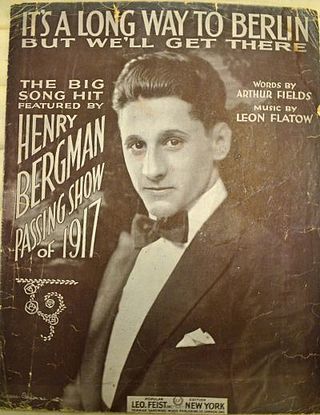
"It's a Long Way to Berlin, but We'll Get There!" is a World War I era song released in 1917. Arthur Fields wrote the lyrics. Leon Flatow composed the music. Leo Feist, Inc. of New York City published the song. Rosenbaum Studios designed the sheet music cover. It features soldiers marching in formation. There is an inset photo of Maurice Burkhardt, Will J. Ward, Ed Morton, Jimmy Flynn, Willie Weston, or Francis Maguire that varies per edition. There is another version of the cover known as the "Popular edition". It features a photo of Henry Bergman.

"Bring Back My Daddy To Me" is a World War I era song released in 1917. William Tracey and Howard Johnson wrote the lyrics. George W. Meyer composed the music. Leo Feist, Inc. of New York, New York published the song.

"Girls of France" is a World War I era song released in 1917. Al Bryan and Edgar Leslie wrote the lyrics. Harry Ruby composed the music. The song was published by Waterson, Berlin & Snyder Co. of New York, New York. Artist Albert Wilfred Barbelle designed the sheet music cover. It features a nurse in the foreground, and soldiers marching behind her. It was written for both voice and piano.
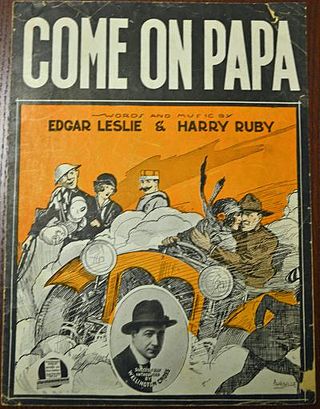
"Come On Papa" is a World War I era song released in 1918.
When I Come Back To You is a World War I song written and composed by William Tracey and Jack Stern. The song was first published in 1918 by Douglas & Newman Music in New York, NY.The sheet music cover depicts a soldier hugging a woman with the Liberty Bell in the background.
















